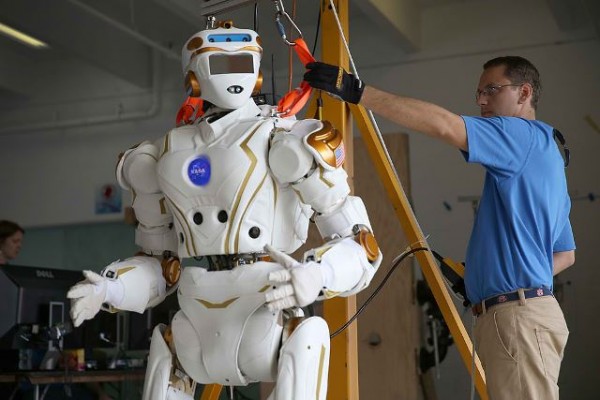NASA Gives Humanoid Robot Valkyrie to MIT, Northeastern University to Develop for Space Missions on Mars
| Daphne Planca | | Nov 19, 2015 01:39 PM EST |
(Photo : Getty Images) NASA is granting advanced Valkyrie prototype automations to two universities - Massachusetts Institute of Technology and Northeastern University in Boston - to conduct research.
NASA is granting advanced Valkyrie prototype automations to two universities to conduct research. Massachusetts Institute of Technology (MIT) and Northeastern University in Boston are getting Valkyrie prototype as part of the program.
Like Us on Facebook
Russ Tedrake will lead the MIT team whereas Taskin Padir will control the Northeastern team.
The humanoid robot is known as Robonaut 5 (R5) or Valkyrie and appeared in the Defense Advanced Research Projects Agency Robotics Challenge in late 2013. It has an undeniable superhero aesthetic, complete with glowing a NASA logo on its chest. It is 6 feet tall, and weighs 290 pounds. It was originally designed for disaster relief missions so it still needs to be tested extensively for a future in space.
NASA is getting ready for human spaceflight with the development of the Orion crew vehicle and Space Launch System. More flexible and detailed missions are achieved if humans are launched into space instead ofrobots, but it is preferable to put a robot at risk rather than a human being.
For this reason, NASA has interest in humanoid robots. Many proposals from various institutions were evaluated before the two colleges were chosen. A grant of $250,000 per year will be given to both teams to fund their research into how the humanoid robot can work in space.
Virtual simulations of humanoid robots and physical demonstration of advanced tasks using the supplied robots will be covered in the research. Also, part of the research will deal with how a humanoid robot will be able to operate on its own, in preparation for human arrival, and in collaboration with human astronauts.
The body plan of the humanoid, in general, was not necessarily the most efficient for a robot, but it is convenient with few complications for human involvement. If a robot is shaped like a person, then it can use all the same equipment and instruments as a human. Better software has to be created so that robots can have more autonomy and dexterity.
Valkyrie is operational with a plethora of sensors such as sonar, LIDAR, and cameras in the head, chest, knees, hands, and feet. The major challenge is how to make use of all that data so that the robot can handle the details on its own. The frontline of human exploration on Mars and beyond will be robots like Valkyrie.
TagsNASA, R5 valkyrie robot, MIT, northeastern university, Humanoid Robot, DARPA robotics challenge, valkyrie
©2015 Chinatopix All rights reserved. Do not reproduce without permission
EDITOR'S PICKS
-

Did the Trump administration just announce plans for a trade war with ‘hostile’ China and Russia?
-

US Senate passes Taiwan travel bill slammed by China
-

As Yan Sihong’s family grieves, here are other Chinese students who went missing abroad. Some have never been found
-

Beijing blasts Western critics who ‘smear China’ with the term sharp power
-

China Envoy Seeks to Defuse Tensions With U.S. as a Trade War Brews
-

Singapore's Deputy PM Provides Bitcoin Vote of Confidence Amid China's Blanket Bans
-

China warns investors over risks in overseas virtual currency trading
-

Chinese government most trustworthy: survey
-

Kashima Antlers On Course For Back-To-Back Titles
MOST POPULAR
LATEST NEWS
Zhou Yongkang: China's Former Security Chief Sentenced to Life in Prison

China's former Chief of the Ministry of Public Security, Zhou Yongkang, has been given a life sentence after he was found guilty of abusing his office, bribery and deliberately ... Full Article
TRENDING STORY

China Pork Prices Expected to Stabilize As The Supplies Recover

Elephone P9000 Smartphone is now on Sale on Amazon India

There's a Big Chance Cliffhangers Won't Still Be Resolved When Grey's Anatomy Season 13 Returns

Supreme Court Ruled on Samsung vs Apple Dispute for Patent Infringement

Microsoft Surface Pro 5 Rumors and Release Date: What is the Latest?










